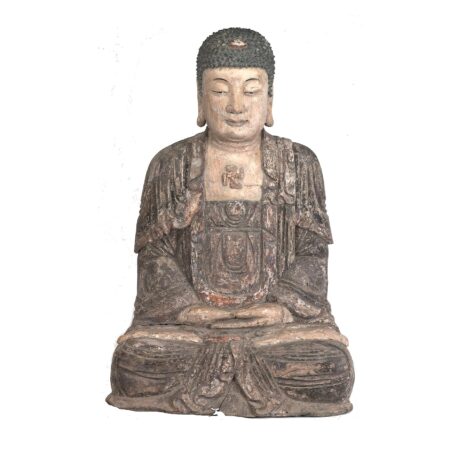SOLD Ming Buddha Shakyamuni with a Wan
$0.00
Ht:31.5″ W: 20″ D: 15″ CALL 213-568-3030 FOR AVAILABILITY INFORMATION
This rare magnificent image of Buddha Shakyamuni is represented in meditation position called Ch’ien Pai Yi Hua-shen (the Hundred Billion Human Manifestations) in Chinese, the position the Buddha assume while seeking enlightenment under the Bodhi tree. Thumbs touching at forming a triangle symbolizing the Three Jewels of Buddhism.
Out of stock
Description
This magnificent and extremely rare image of Buddha Sakyamuni is seated meditation (dhyana mudra) hands in the lap and feet in lotus position (padmasana) upturned bare feet placed on the thighs. Meditation is one of the most frequently mudras for Sakyamuni, epitomizing perfect physical and spiritual balance and thought to be the position he assumed under the Bodhi tree before his Enlightenment. The thumbs touch forming a triangle, which in images of the Buddha symbolize the triratna (Three Jewels of Buddhism): the Buddha, the Dharma (the Buddhas teachings) and the Sangha (the religious community of monks). The three creases on his neck are a visual representation of his enlightenment and spiritual development. He has features of a great and exceptional spiritual being referred to collectively as lakshana which include the cranial protuberance on his head denoting the seat of his power, wisdom, and divine energy and a hemisphere at its center symbolizing the radiating light of wisdom. He also has the elongated earlobes of a wise and enlightened being. His head is “snail crowned’ with spiral curls, an allusion to the Indian legend that he while he was so focused in meditation on helping all sentient beings, snails formed a covering to protect his head from the sun’s rays. His face radiates serenity with its benign expression, emphasized by downcast eyes of inset glass under arched painted eyebrows, an aquiline nose and a slightly smiling mouth. On his bare chest is a Buddhist swastika with the ends facing right to move clockwise. An Indian symbol, sv-asti in Sanskrit means prosperity, well-being, good fortune or success. In Buddhism it is called a wan, the number ten thousand, symbolizing infinity and auspiciousness. It is a sacred symbol often seen on the heart of Sakyamuni images, as it is believed to contain within it the whole mind and heart of the Buddha. He wears a three-part monk’s robe with cascading folds and over a dhoti (the lower garment) gathered at the waist. The shawl over his shoulders extends to the back of the image
Sakyamuni is the principal Buddha and the source of Buddhist teachings. He is the fourth Buddha of the present kalpa (era), and it is believed he will be followed by the fifth Maitreya, known in China as Mi-lo-Fu, in some three thousand years. This consecrated sculpture was probably placed on the main altar in the Second Hall of the Buddhist Temple. This hall referred to as the Precious Hall of the Great Hero, contained figures of Sakyamuni Buddha, sometimes accompanied by Buddha Amitabha and Manjusri (Wen Shu Shih-Li).
Additional information
| Place of Origin | China |
|---|---|
| Period | Antique, Ming Dynasty |
| Date | 16-17th Century |
| Materials and Technique | Wood |
| Dimensions (inches) | Ht: 31.5” W: 20” D: 15”, |
| Dimensions (metric) | Ht: 80.01cm W: 50.8cm D: 38.1cm |
| Item Number | 16271LHEM |
| Condition | Excellent, minor scratches/paint losses consistent with age and use, no restorations/repairs |
| Shipping Box Size | Oversized. Call 213-568-3030 or email [email protected] for shipping. |

